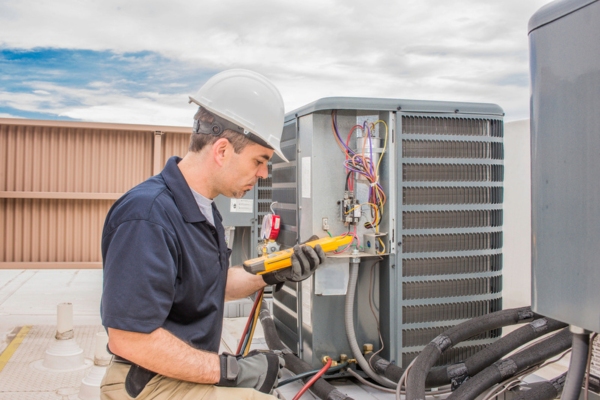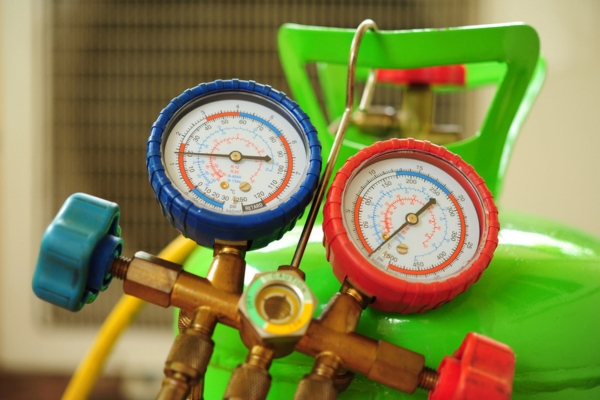Table of Contents
- Should You Replace Just the Outdoor Air Conditioning Unit?
- Advantages of Replacing Both Indoor and Outdoor Air Conditioning Units
- Air Conditioner Maintenance Tips
- FAQs on Replacing Air Conditioning Systems
- Can I Pair an Indoor Unit From One HVAC Manufacturer With an Outdoor Unit From Another?
- What Are the Signs of a Mismatched HVAC System?
- How Long Does Replacing Both Indoor and Outdoor Air Conditioner Units Typically Take?
- Can I Upgrade My AC System Without Replacing the Ductwork?
- Does Replacing My HVAC System Offer Any Health Benefits?
- Conclusion
- Contact Lake Region Energy for All Your HVAC Needs
The US Department of Energy recommends replacing your HVAC system every 10 to 15 years. However, with high-quality systems and regular maintenance, they can last longer than 15 years.
To ensure your system operates effectively, it’s crucial to schedule professional maintenance and tune-ups twice a year, particularly before the demanding summer and winter seasons.
At times, a complete replacement of your HVAC system becomes necessary. A frequent question among homeowners regarding air conditioning units is, “Can you replace just the outside AC unit?” Lake Region Energy, your trusted local HVAC service provider, will address this common query in this discussion.
Should You Replace Just the Outdoor Air Conditioning Unit?

The simple answer is no. HVAC experts recommend replacing both the indoor and outdoor units of your air conditioning system simultaneously. While the decision ultimately lies with you, opting to replace only one component can result in reduced efficiency, increased likelihood of breakdowns, and higher cooling costs.
Here are further reasons why replacing both units together is crucial for maintaining peak performance.
Considering an HVAC Upgrade? Maximize your system’s efficiency with a perfectly matched indoor and outdoor unit. Reach out to Lake Region Energy today!
Matching Indoor and Outdoor AC Units for Optimal Efficiency
The Air-Conditioning, Heating, and Refrigeration Institute (AHRI) stresses the need for outdoor AC units to be compatible with their corresponding indoor units (air handlers) to achieve optimal efficiency. The outdoor unit must be specifically designed to match the indoor one, ensuring seamless operation together.
Replacing only the outdoor AC unit can result in a mismatched system that fails to meet your heating and cooling demands effectively. Operating such a mismatched system can lead to several problems, including reduced indoor comfort, the likelihood of early system failures, and higher operational costs caused by inefficiency.
Understanding SEER Ratings
SEER stands for Seasonal Energy Efficiency Ratio. It measures an air conditioner’s cooling efficiency by comparing its cooling output during a typical season to its yearly energy usage. This rating is a key benchmark for assessing an HVAC system’s efficiency. The US Energy Information Administration (EIA) mandates a minimum SEER rating of 13 for all systems in the United States.
A higher SEER rating indicates greater efficiency in an HVAC system, which leads to lower operational costs and a smaller environmental footprint throughout its lifetime.
For maximum efficiency, both the indoor and outdoor units of an AC system should have matching SEER ratings. Replacing only the outdoor unit without matching the indoor unit can create a mismatch in SEER ratings, causing inefficiencies and various related problems.
A mismatched system may experience decreased cooling efficiency, heightened energy use, and a greater risk of mechanical failures. This highlights the need to consider SEER ratings when upgrading any part of your HVAC system.
Ready to Cut Cooling Costs?: Switch to a modern, energy-efficient AC system and enjoy significant savings. Contact us today!
Transitioning Away from R-22 Refrigerant

In response to global sustainability efforts, HVAC manufacturers are transforming their practices by adopting eco-friendly designs and materials. This shift is designed to minimize the environmental impact of HVAC systems and align with broader conservation goals.
Older HVAC systems often relied on R-22 refrigerant. This coolant was identified by the U.S. Environmental Protection Agency (EPA) as harmful to the ozone layer. This recognition has driven substantial changes in industry standards and practices.
In response to these environmental issues, federal energy regulations now mandate using environmentally friendlier options in all new HVAC units. These alternatives are noted for their reduced environmental impact and enhanced safety characteristics.
For homeowners with systems still using R-22, upgrading to models that use more eco-friendly refrigerants represents more than just an improvement in efficiency; it’s a pledge to environmental responsibility. Upgrading ensures compatibility between indoor and outdoor units, avoiding the problems and inefficiencies of mismatched components and aligning home energy use with modern environmental standards.
Manufacturer Warranty on HVAC Systems
A new HVAC system comes with a manufacturer’s warranty that covers defects or imperfections in factory-installed parts, protecting against unexpected breakdowns. However, this warranty may be voided or repairs under warranty denied if the outdoor and indoor units are not properly matched, as stipulated by the manufacturer or dealer.
Is It Time to Replace Your Cooling System? Upgrade to a reliable, energy-efficient cooling system tailored for your home. Contact us now!
Durability and Maintenance of Cooling Systems
A well-maintained and correctly matched HVAC system can reliably function for over a decade. On the other hand, a mismatched system tends to overwork due to inefficiency, drastically shortening its lifespan.
Replacing only one component of the system can lead to inefficiencies that accelerate its deterioration and increase the frequency of repairs. To avoid these issues, it’s recommended to replace the indoor and outdoor units at the same time, enhancing the system’s efficiency and durability.
Cost Implications of Partial AC Replacement

Initially, replacing just the outdoor or indoor unit might appear to be a cost-saving strategy, but it typically leads to higher long-term expenses. Here’s why:
- Increased Energy Bills: A mismatched system runs inefficiently, using more electricity to achieve the desired indoor temperature, which translates to higher utility costs each month.
- More Frequent Repairs: Mismatched HVAC components have to work harder, making them more susceptible to breakdowns. This leads to repeated repair expenses that accumulate over time.
- Premature System Replacement: An inefficient or mismatched system faces accelerated wear, reducing its lifespan and potentially leading to an early replacement, which negates initial savings.
- Financing and Rebates: Many utility companies, manufacturers, and local governments offer incentives for upgrading both units to a high-efficiency system. These financial incentives can help offset the initial costs significantly.
Experience Enhanced Comfort: Upgrade to a new air conditioner that cools your home evenly and efficiently. Book your consultation today!
Advantages of Replacing Both Indoor and Outdoor Air Conditioning Units
- Reduce Cooling Costs: Even with a high SEER rating, a mismatched system operates inefficiently, often overworking to achieve the necessary cooling. This results in increased energy consumption and higher energy bills.
- Enhanced Home Comfort: A correctly matched AC unit operates more efficiently, cooling your home properly and improving overall comfort.
- Valid HVAC Warranty: As noted earlier, the manufacturer’s warranty stays valid only if the indoor and outdoor units match. Replacing both ensures your new AC units are fully covered under warranty.
Air Conditioner Maintenance Tips

To avoid premature system failure and unnecessary replacements, keep your air conditioner running smoothly with these maintenance tips:
- Regularly clean or replace the HVAC air filter to maintain airflow and efficiency.
- Ensure the fan operates correctly for optimal performance.
- Install a programmable thermostat to manage cooling efficiently.
- Have a professional inspect and unclog the condensate drain as needed.
- Verify that your AC system components are matched for the best efficiency.
- Reduce system operation when not needed by adjusting temperature settings.
- Perform routine HVAC checks to identify and resolve issues promptly.
- Schedule an annual tune-up each spring to prepare for summer.
While these maintenance actions can’t guarantee that your system won’t ever fail, they will likely extend your HVAC unit’s lifespan, enhance its efficiency, and reduce cooling costs. For expert HVAC maintenance and repairs, reach out to a qualified contractor who specializes in air conditioning.
Looking for a Smooth Air Conditioning Replacement? Let our experts manage the installation from beginning to end. Contact us today!
FAQs on Replacing Air Conditioning Systems

Can I Pair an Indoor Unit From One HVAC Manufacturer With an Outdoor Unit From Another?
This practice is highly discouraged. Even if the units share the same SEER rating, they might not be designed to operate effectively together. Discrepancies in design, pressure levels, and airflow needs can lead to operational inefficiencies, higher energy costs, and faster deterioration of parts. Moreover, most manufacturers stipulate that systems must be matched to uphold warranty coverage so that mismatched components may lead to voided warranties.
What Are the Signs of a Mismatched HVAC System?
A mismatched HVAC system typically fails to maintain even temperatures across your home. Signs of this issue include uneven heating or cooling between rooms, prolonged or frequent cycling of the system, and increased energy bills without a corresponding rise in usage. Over time, mismatched components can suffer from accelerated deterioration, resulting in frequent breakdowns and expensive repairs.
How Long Does Replacing Both Indoor and Outdoor Air Conditioner Units Typically Take?
The replacement of both indoor and outdoor air conditioning units generally takes an entire workday, about 6 to 8 hours. This duration can differ based on the complexity of the job. If the installation involves additional tasks like ductwork repairs, system calibration, or smart thermostat setup, it may extend the time required. Our technicians focus on efficient and thorough installation to guarantee reliable operation from the start.
Exploring Air Conditioning System Replacement Options? Our experts can guide you in selecting the ideal system tailored to your home’s cooling requirements. Reach out to us today!
Can I Upgrade My AC System Without Replacing the Ductwork?
Yes, you can upgrade without replacing the ductwork if it’s in good condition and correctly sized. However, old, damaged, or improperly sized ducts can impair your new system’s performance and efficiency. Sealing or updating your ductwork can enhance airflow, decrease energy waste, and improve overall comfort.
Does Replacing My HVAC System Offer Any Health Benefits?
Definitely. Modern HVAC systems come equipped with advanced filtration, humidity control, and enhanced air circulation. These features significantly lower the presence of airborne pollutants like dust, allergens, and mold spores, boosting indoor air quality. Improved air quality can help ease allergy symptoms, lessen respiratory problems, and foster a healthier environment for your family.
Conclusion
There are compelling reasons to replace both your indoor and outdoor AC units simultaneously. Remember, units from different manufacturers are mismatched even if they share the same SEER rating. To ensure your HVAC system is properly matched, it’s essential to engage a qualified HVAC contractor to replace both units.
Upgrade for Enhanced Comfort and Savings! Investing in a new system boosts home comfort and reduces energy costs. Contact us today to begin your upgrade!
Contact Lake Region Energy for All Your HVAC Needs
Lake Region Energy provides top-notch heating and cooling services across Maine and New Hampshire. Our team of professionally certified technicians is equipped to deliver exceptional HVAC tune-ups, repairs, installations, and replacements. Each technician brings knowledge and experience to service your HVAC system properly.
We pride ourselves on offering the most competitive heating and cooling service prices in the region. Our maintenance services are made to enhance your comfort and energy efficiency and cut down on your heating and cooling expenses. If you need an HVAC repair or are considering a new system, we can guide you to the best options within your budget. We stand behind our work with a satisfaction guarantee.
To set up a service appointment or for a free in-home consultation, call Lake Region Energy today. Call now!
For more information about our HVAC services and fuel deliveries, be sure to contact Lake Region Energy. You can click here to contact us, or you can call us at (207) 839-5500 to find out more. We offer a full line of heating and cooling repairs, maintenance services, and installations. Click the link to view our service area.

Related Articles:
- Homebuying Tips: 5 Things To Check When Buying A House With An Old HVAC
- Cool Revolution: The Evolution Of Air Conditioner Comfort
- Understanding The Distinction: Air Conditioner Vs. Heat Pump
- How Does An Air Conditioner Work? A Simple Guide
- Why New Air Conditioners Are More Energy-Efficient Than Ever
